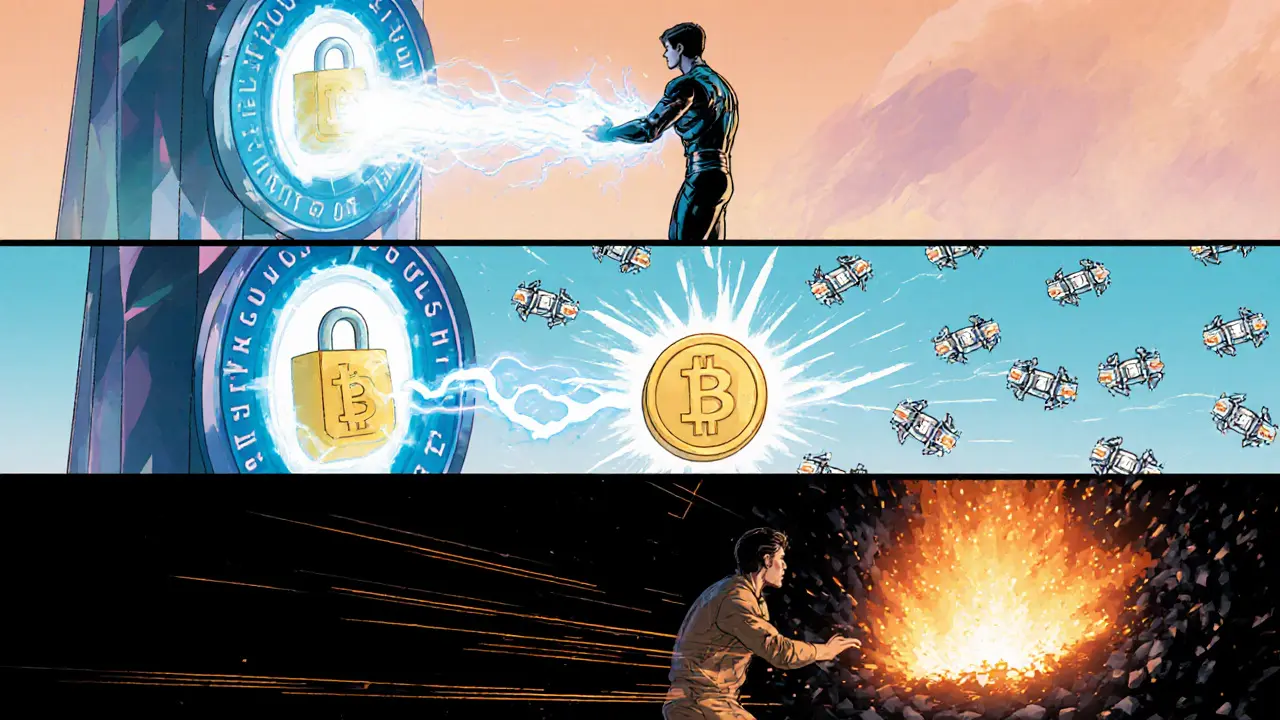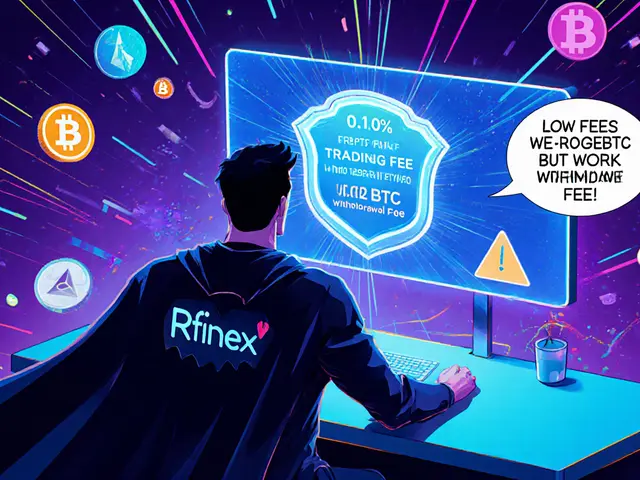- Home
- Cryptocurrency
- Understanding Cross-Chain Bridges in Crypto: How They Connect Blockchains

Understanding Cross-Chain Bridges in Crypto: How They Connect Blockchains
Cross-Chain Bridge Explorer
Cross-Chain Bridge Overview
Cross-chain bridges connect separate blockchain networks, allowing digital assets, data, and commands to move between ecosystems that otherwise can't communicate. They're essential for the growing multi-chain crypto ecosystem.
Bridge Comparison
| Aspect | Trusted Bridge | Trustless Bridge |
|---|---|---|
| Control | Managed by a single entity or consortium | Operates via decentralized validator set or smart contracts |
| Risk Profile | Subject to custodian failure, hack, or insider misbehavior | Security relies on code and economic incentives, no central custodian |
| Speed | Faster due to fewer on-chain confirmations | May require multiple block confirmations on each chain |
Lock-Mint-Burn Process
This process ensures constant supply across chains, preventing double-spending.
Security Considerations
- High-profile hacks show vulnerabilities in validator logic or smart contracts
- Start small when testing new bridges
- Check if bridges have undergone reputable security audits
- Prefer trustless designs over centralized ones
Bridge Recommendation
Based on your selections, we recommend exploring trustless bridges for maximum security, especially for valuable assets.
Cross-Chain Bridge is a protocol that links two separate blockchain networks, allowing digital assets, data, and commands to move between ecosystems that otherwise can’t communicate. As the crypto world expands beyond a handful of major chains, users increasingly hit a wall when they try to send Bitcoin to an Ethereum‑based DeFi app or move an NFT from Solana to Polygon. Bridges break down that wall, turning isolated blockchains into a fluid, multi‑chain playground.
Why Bridges Matter: The Interoperability Problem
Imagine every city in the world had its own currency and no banks accepted foreign money. Travelers would need to carry multiple wallets, and businesses would lose customers who can’t pay. Blockchains face the same issue. Bitcoin, Ethereum, Solana, Avalanche, and dozens of others each have unique consensus rules, transaction formats, and token standards. Without a way to translate value across these borders, assets stay locked in their native chains, limiting utility and liquidity.
Cross‑chain bridges provide the translation layer. By moving tokens, NFTs, or even arbitrary data, they let users tap the best features of each network - cheap fees on Binance Smart Chain, fast finality on Solana, rich smart‑contract tooling on Ethereum - all without swapping on a centralized exchange.
How Bridges Work: Lock‑Mint‑Burn Cycle
At the core of most bridges is a simple accounting trick: lock the original asset on the source chain and mint a “wrapped” version on the destination chain. The process typically follows three steps:
- Lock: A smart contract on the source blockchain receives the user’s tokens and holds them in escrow. The contract emits an event confirming the lock.
- Mint: A validator set, relayer network, or another smart contract reads the lock event and creates an equivalent amount of a wrapped token on the target chain. The new token mirrors the original’s value 1:1.
- Burn / Unlock: When the user wants to return to the original chain, they send the wrapped token back to the destination contract, which burns (destroys) it. The source contract then releases the locked tokens to the user’s address.
This lock‑mint‑burn loop maintains a constant supply across both chains, preventing double‑spending. A real‑world example is Wrapped Bitcoin (WBTC) a token on Ethereum that represents Bitcoin locked in custody. Users can trade WBTC on Ethereum DEXs just like any ERC‑20 token, while the underlying Bitcoin stays safely stored on the Bitcoin network.
Bridge Architectures: Trusted vs. Trustless
Not all bridges are built the same. The main divide is between trusted (centralized) designs and trustless (decentralized) designs.
| Aspect | Trusted Bridge | Trustless Bridge |
|---|---|---|
| Control | Managed by a single entity or consortium | Operates via decentralized validator set or smart contracts |
| Risk Profile | Subject to custodian failure, hack, or insider misbehavior | Security relies on code and economic incentives, no central custodian |
| Speed | Often faster because fewer on‑chain confirmations needed | May require multiple block confirmations on each chain |
| Examples | Binance Bridge, Crypto.com Bridge | Wormhole a trustless bridge linking Ethereum, Solana, BSC and other chains, Thorchain a decentralized liquidity protocol enabling native asset swaps across chains |
Trustless bridges preserve decentralization but often face higher complexity and occasional outages. Trusted bridges can be more user‑friendly but re‑introduce a single point of failure.
Notable Bridge Protocols
Below are a few of the most widely used bridges and what makes each unique.
- Wormhole connects Ethereum, Solana, BNB Chain, and others through a network of guardian nodes. It supports both token transfers and cross‑chain messages, allowing dApps to trigger actions on another chain.
- Polkadot offers a set of parachains that can communicate via a shared relay chain, providing native interoperability. Its XCMP (Cross‑Chain Message Passing) protocol lets assets move without a separate lock‑mint contract.
- Cosmos uses the Inter‑Blockchain Communication (IBC) protocol to transfer tokens and data between independent zones.
- Atomic Swaps enable peer‑to‑peer token exchanges across chains without an intermediary, using hash time‑locked contracts (HTLCs).
- Thorchain provides a liquidity network that lets users swap native assets (e.g., BTC, ETH) directly across chains.

Practical Use Cases: Moving Value Across Chains
Bridges solve real‑world friction points for everyday crypto users.
- Yield Farming on a Cheaper Chain: A DeFi trader can lock USDC on Ethereum, mint USDC on Arbitrum via a bridge, and earn higher yields on cheaper gas fees.
- NFT Portability: Artists mint an NFT on Solana for low minting costs, then bridge it to Ethereum to tap the larger marketplace audience.
- Cross‑Chain Payments: A freelancer paid in Bitcoin can bridge the BTC to Polygon, instantly paying for services that only accept MATIC‑based tokens.
- Liquidity Aggregation: Decentralized exchanges like SushiSwap integrate multiple bridges, allowing traders to access deep liquidity pools spread across several chains without leaving the UI.
All of these scenarios avoid the time‑consuming, KYC‑heavy process of using centralized exchanges, preserving the permissionless spirit of Web3.
Security Considerations: The Risks Behind Bridges
Because bridges manage locked assets, they attract attackers. High‑profile hacks-like the 2022 Wormhole breach that exposed $320million-show that vulnerabilities in validator logic, smart‑contract code, or off‑chain relayer infrastructure can lead to massive losses.
Key safety tips for users:
- Start Small: Test a bridge with a tiny amount before moving large sums.
- Check Audits: Use bridges that have undergone reputable third‑party security audits.
- Prefer Trustless Designs: When possible, choose bridges that rely on decentralized validator sets rather than a single custodian.
- Watch Community Signals: Follow bridge developers’ channels for outage notices or emergency patches.
Future Outlook: Toward a Fully Interconnected Crypto Ecosystem
Interoperability is emerging as the next layer of blockchain innovation, much like the transition from isolated computers to the internet. Projects such as LayerZero and Hyperlane are building generic messaging layers that any chain can adopt, reducing the need for bespoke bridge contracts.
As more DeFi protocols, NFTs, and gaming platforms design multi‑chain strategies, the demand for reliable bridges will only grow. Expect to see tighter standards (e.g., ERC‑4337 for account abstraction) that make cross‑chain actions smoother, and increased use of zero‑knowledge proofs to verify bridge events without exposing on‑chain data.
Key Takeaways
- Cross‑chain bridges let tokens and data move between otherwise isolated blockchains.
- They work by locking the original asset on one chain and minting a wrapped version on another.
- Bridges come in trusted (centralized) and trustless (decentralized) flavors, each with trade‑offs.
- Popular protocols include Wormhole, Polkadot, Cosmos, Atomic Swaps, and Thorchain.
- Security remains the biggest challenge; users should start small, verify audits, and prefer decentralized designs.
Frequently Asked Questions
What is the difference between a wrapped token and the original asset?
A wrapped token is a blockchain‑native representation of an asset that lives on a different chain. It is minted 1:1 when the original asset is locked in a smart contract, and it can be burned to release the original asset back to its native network.
Are trustless bridges completely risk‑free?
No. While they eliminate a single custodian, they still rely on complex smart‑contract code and validator economics. Bugs, faulty implementations, or insufficient incentives can still be exploited, as seen in past bridge hacks.
Can I bridge NFTs the same way I bridge ERC‑20 tokens?
Yes, but the bridge must support the NFT standard (ERC‑721 or ERC‑1155) on both sides. The process still follows lock‑mint‑burn, with the NFT’s metadata preserved in the wrapped version.
How do atomic swaps differ from bridge contracts?
Atomic swaps are peer‑to‑peer trades that use hash time‑locked contracts to ensure both sides fulfill the exchange simultaneously, without a third‑party bridge. Bridges, by contrast, lock an asset and mint a counterpart on another chain, often involving a relayer or validator set.
What future standards might simplify cross‑chain communication?
Emerging standards like Inter‑Blockchain Communication (IBC) for Cosmos, LayerZero’s ultra‑light nodes, and zero‑knowledge proof‑based verification aim to create universal messaging layers. These would let any chain speak to any other with minimal custom code.
Cormac Riverton
I'm a blockchain analyst and private investor specializing in cryptocurrencies and equity markets. I research tokenomics, on-chain data, and market microstructure, and advise startups on exchange listings. I also write practical explainers and strategy notes for retail traders and fund teams. My work blends quantitative analysis with clear storytelling to make complex systems understandable.
6 Comments
Write a comment Cancel reply
About
DEX Maniac is your hub for blockchain knowledge, cryptocurrencies, and global markets. Explore guides on crypto coins, DeFi, and decentralized exchanges with clear, actionable insights. Compare crypto exchanges, track airdrop opportunities, and follow timely market analysis across crypto and stocks. Stay informed with curated news, tools, and insights for smarter decisions.





Cross-chain bridges are just glorified middlemen with a smart contract label. If you really wanted decentralization, you'd use atomic swaps or just stick to one chain. This whole interoperability hype is just VC-funded noise to keep people trading instead of holding.
Let me guess-you think Wormhole’s ‘decentralized’ validator set is secure? Please. The 2022 exploit wasn’t a bug-it was a coordinated exploit of naive governance. These bridges aren’t protocols, they’re honeypots for institutional whales and script kiddies with 12-node setups. And don’t get me started on how LayerZero’s oracle model is just a rebranded PoA chain with a fancy whitepaper.
Zero-knowledge proofs? Cute. But if your bridge relies on a relayer that’s not audited by Trail of Bits, you’re already dead money. I’ve seen 37 bridge exploits in the last 18 months. Not one had a proper formal verification. This isn’t innovation-it’s financial Russian roulette with a UI.
Everyone’s acting like bridges are the future, but nobody’s talking about how they’re the biggest threat to blockchain’s original promise: censorship resistance. You think locking BTC in a contract on Ethereum makes you free? You’re just trading one centralized custodian for another. And who’s to say the ‘guardian nodes’ on Wormhole aren’t just Coinbase employees in disguise?
Meanwhile, real DeFi people are using atomic swaps and self-custody. But no, we’re all supposed to be excited about wrapped tokens and gas fees on Arbitrum. Wake up. This isn’t progress-it’s a slow pivot back to Wall Street.
Oh wow, you actually wrote a whole article about bridges… and didn’t mention the 2023 Nomad hack? Or the $190M on Polygon’s bridge exploit? Or the fact that 90% of these ‘trustless’ bridges have a single admin key hidden in a GitHub repo that nobody audited? You’re not educating people-you’re handing them a loaded gun and calling it a ‘tool’.
And yes, I’m talking to you, Mike Kimberly, with your ‘cultural ambassador’ nonsense. No, I don’t care that you think IBC is ‘elegant’. When your wallet’s empty because a relayer went offline, you won’t be quoting whitepapers-you’ll be begging for airdrops.
I appreciate the breakdown on how bridges work-it’s easy to get lost in the hype. I started small with a $5 transfer on Wormhole just to see how it felt, and honestly, it was smoother than I expected. The UI was clear, and the confirmation time was under 3 minutes.
I still don’t trust them with my life savings, but for moving small amounts between chains to access niche DeFi pools? It’s useful. I’d just recommend everyone do what I did: test with pennies first, check the bridge’s audit report (if it’s on CertiK or PeckShield), and never assume ‘trustless’ means ‘riskless’.
Also, if you’re new to this, don’t panic if your transaction takes longer than expected. Sometimes it’s just network congestion-not a hack.
The real story here isn’t the technical architecture of bridges-it’s the philosophical shift they represent: the move from isolated, sovereign chains to an interconnected digital economy. This isn’t merely about moving tokens; it’s about enabling a new class of cross-chain applications that can dynamically allocate liquidity, orchestrate multi-chain smart contracts, and even deploy decentralized governance across heterogeneous networks.
Consider Cosmos’ IBC protocol: it doesn’t wrap assets-it transports them as native objects, preserving their intrinsic properties. This is fundamentally different from the lock-mint-burn model, which, while effective, introduces synthetic representations that dilute the original asset’s provenance.
And while trustless bridges are ideal in theory, their operational complexity often leads to unintended attack surfaces. The future lies not in more bridges, but in standardized, interoperable messaging layers-like LayerZero’s ultra-light nodes-that abstract away the underlying chain differences entirely, allowing developers to write once and deploy everywhere.
Moreover, the integration of zero-knowledge proofs for cross-chain verification could eliminate the need for validator sets altogether, replacing them with cryptographic proofs that are verifiable on-chain without revealing sensitive data. This isn’t just an upgrade-it’s a paradigm shift.
What we’re witnessing is the emergence of a true blockchain internet: not a collection of silos, but a unified, interoperable network where value, data, and computation flow freely, securely, and without intermediaries. The bridges we have today are the telegraphs of this future-the first crude attempts at connection. The real revolution is still being coded.